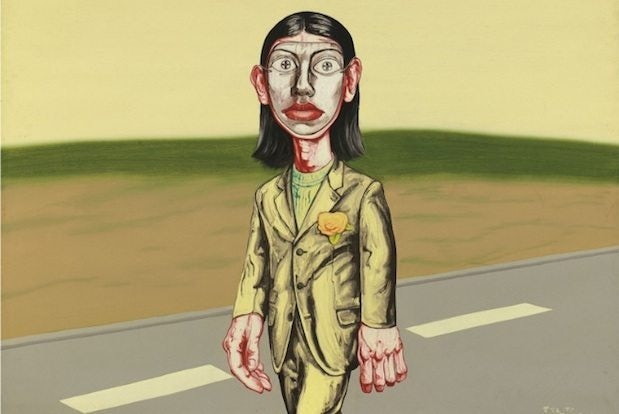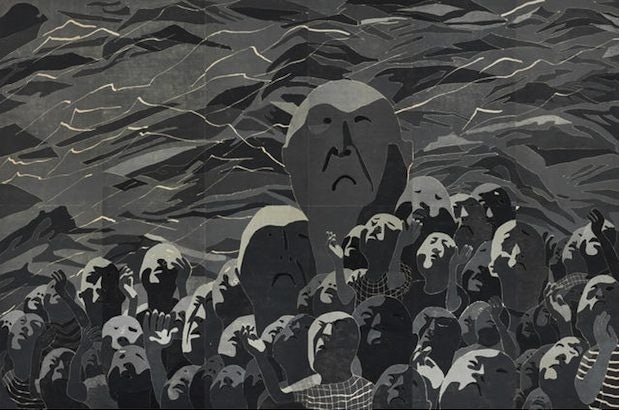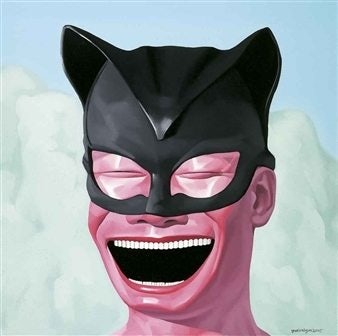
Zeng Fanzhi’s Mask Series 1997 No. 17 is expected to sell for between $2.5 and $3.2 million at Christie's upcoming Hong Kong auction. (Christie's)
As art prices skyrocket to pre-recession levels, modern and contemporary works by both Western and Chinese artists have seen record-high sales over the past year. Despite stellar auction results, however, a huge gap remains between top sales amounts commanded by each category—for example, Western artist Francis Bacon’s Three Studies of Lucian Freud set the record for the most expensive piece of art sold at auction with a cost of $142.4 million, while Zeng Fanzhi’s The Last Supper holds the Chinese contemporary record with a comparatively modest value of $23.3 million. Prices of works by other top Chinese contemporary artists such as Zao Wou-Ki, Zhang Xiaogang, and Chu Teh-Chun lag behind those of their Western peers as well.
This discrepancy may not be so wide for long, however. The record-setting results of Christie’s New York auctions last week have shown that a growing number of wealthy Chinese collectors are a major factor in sky-high Western prices—and Chinese art is not far behind on their agenda.
Christie’s May 13 auction of postwar and contemporary art in New York netted $745 million—the highest total for a single auction in art market history—thanks in large part to Chinese buyers. The New York Times reports that half of the evening’s top 10 works were bought by Asian buyers who placed bids over the phone with Xin Li, the deputy chairman of Christie’s Asia. In total, Christie’s Post-War and Contemporary Art department set the world record for an auction week as well, raising a staggering $975 million in total.
According to reports, avid Chinese collectors frequently out-priced key figures in the global art world in fierce bidding wars. Top lots purchased by mainland Chinese collectors included Francis Bacon’s Three Studies for a Portrait of John Edwards for $80.8 million, Jeff Koons’ Jim Bean—J.B. Turner Train for $33.7 million, and Alexander Calder’s Flying Fish for $25.9 million, topping its high estimate of $12 million. These results followed a pattern of Chinese collectors' growing influence on blue-chip art prices. Earlier this month, a Chinese telephone buyer bought Monet’s Water Lilies for $27 million at another Christie’s New York auction, while billionaire Wang Jianlin paid $28 million for a Picasso painting last November.
Christie’s is likely betting on the strength of Chinese buyers for its upcoming May 24 Hong Kong Asian and 2oth Century Contemporary Art Evening Sale, but prices of works by Chinese contemporary artists are still low compared to the top amounts for Western pieces sold in New York. For example, highlights include Zeng Fanzhi’s Mask Series 1997 No. 17, which is estimated to sell for between $2.5 and $3.2 million, Sanyu’s Potted Chrysanthemums, which has an estimate of $2.3 to $2.8 million, Liu Wei’s Swimming, which is estimated to bring in between $1.4 million and $1.9 million, and Yue Minjun’s Fools in the Night, which has an estimate of $1 to $1.5 million. Several additional pieces by Zeng, Zhang Xiaogang, Liu Ye, Zhang Wan, and Li Shan are available in the $1 million or six-digit range.
Mid-range works by highly recognized Chinese artists at Christie's Hong Kong Asian Contemporary Art Day Sale the next day are also relatively inexpensive when contrasted with comparable Western works. Highlights of this sale include Fang Lijun's set of six woodblock prints entitled 1999.3.1, and Yue Minjun's Hat Series: Cat Woman, which both fall in the estimate of $129,605 to $194,408. Both artists have gained extensive art world prestige—Fang's work most recently appeared at the Metropolitan Museum of Art's Ink Art Chinese contemporary art exhibit—meaning that prices of their works can only go up as more Chinese collectors recognize their value.

Fang Lijun's set of six woodblock prints entitled 1999.3.1 are expected to sell for between $129,605 and $194,408 at Christie's upcoming Hong Kong auction. (Christie's)
Meanwhile, a significantly wider contingent of blue-chip contemporary Western artists such as Chris Wool, Jeff Koons, Jean-Michel Basquiat, and Joan Mitchell often sell for prices that are typically only reserved for the top one or two lots of a typical Asian contemporary art auction. For example, the top 10 lots of Christie’s recent contemporary art auction in New York on May 12 were all in the range of $4 million to $18 million, with sales of mid-range works by Koons, Basquiat, Andy Warhol, Peter Doig, and Martin Kippenberger among the highlights. No works by Chinese contemporary artists have sold for above the $25 million mark, while Koons, Jasper Johns, and Wool—the world’s most expensive living American artists—have seen record sales of $58.4 million, $28.6 million, and $26.5 million, respectively. Many works by young Western artists still devoid of a museum show have often sold for prices far higher than those of established Chinese artists with a solid history, such as the Chinese works featured in the Metropolitan Museum of Art’s recent exhibit.

Yue Minjun’s Hat Series: Cat Woman is expected to sell for between $129,605 and $194,408 at Christie's upcoming Hong Kong auction, making it a prime investment piece thanks to the artist's blue-chip status. (Christie's)
Chinese art prices are unlikely to remain so "cheap" for long, however. For now, Chinese contemporary is a relative bargain compared to works by Western artists, but that will change as even more Chinese collectors willing to pay top dollar for art as an investment enter the market. Recent record sales such as Zeng’s Last Supper and an artist record set by Zhang Xiaogang have been influenced by the fact that collectors are holding onto the most important works with an eye on new Chinese collectors and the market’s future potential. While high-quality pieces by Chinese-French painters such as Zao Wou-Ki and Chu Teh-Chun are relatively abundant at auctions such as the upcoming Christie's sale, the most highly valued works by blue-chip mainland artists such as Zhang, Zeng, and Yue Minjun are scarce and bring in top prices when they appear.
For collectors looking for the next big art investment opportunity, Chinese contemporary works are a solid bet thanks not only to the growing number of wealthy Chinese collectors entering the contemporary market, but also to their willingness to spend big on works. This was demonstrated most recently at Christie’s in New York, but is likely to be repeated at auctions across the world in coming years for both Asian and Western pieces—making now the time to buy for savvy bidders.